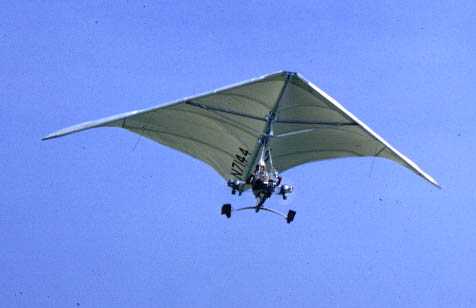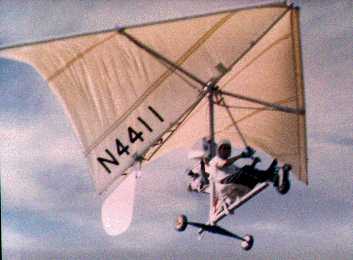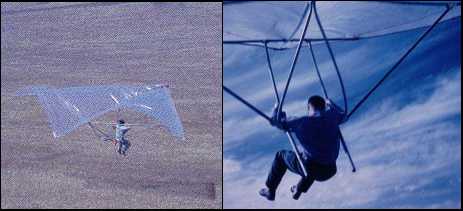

Completed in March of 1967, This is possibly the earliest example of a trike. "Paraplane" used two West Bend (Chrysler) 820 engines (8hp @6000rpm, reduced to 4700rpm maybe 6.5hp for a total of 13hp, for propeller matching reasons) direct driving a pair of two blade 27in diameter polyester fiberglass over balsa propellers. The craft took off, flew, and landed at very near to 25mph.
The craft, which had a 26.5 foot wingspan and weighed 145# empty with a 180# payload, originally started out with 32in diameter 1 blade propellers, with counterweights and flapping hinges, but one of these units tossed itself out of the test zone and made the designer go conservative.
With a rate of climb with the two blade propellers of only 60 feet per minute, the craft, though very docile in handling, took careful power management when flying at low levels. One time someone walked out onto the middle of the runway as the craft was coming in, to photograph as it came in, leaving the only option to land in the 'glades next to the runway. This machine, once committed to landing, simply did not want to climb out before touching down!
The primary frame structure was 2in sq architectural sections, with the 17 foot long main spars and spreader made from bolted 6061-T6 aluminum tubing. The craft spring landing gear was polyester fiberglass over balsa construction. A plastic kitchen chair was used for the seat and the engines were started from the seat using recoil starters.
The designer went on to build two additional craft of this nature, no plans are
to be drawn for these craft. ![]()
![]()

![]()
 The second craft, Skyhook, in spite
of its early date of origin, had most of the attributes of a modern ultralight,
except it used a single cylinder snowmobile engine, as the twins were not
available at the early date. It was powered by a 17hp at 5000rpm single cylinder
JLO L297 two stroke engine, driving a composite propeller designed and built by
this designer, via a 2.1/1 reduction gearbox. The engine was electric start, and
the craft had fiberglass composite spring landing gear. Airframe construction
was bolted 6061-T6 aluminum thin wall tube, with 6061 T-6 extruded angle. The
craft took off, flew, and landed at very near 30mph.
The second craft, Skyhook, in spite
of its early date of origin, had most of the attributes of a modern ultralight,
except it used a single cylinder snowmobile engine, as the twins were not
available at the early date. It was powered by a 17hp at 5000rpm single cylinder
JLO L297 two stroke engine, driving a composite propeller designed and built by
this designer, via a 2.1/1 reduction gearbox. The engine was electric start, and
the craft had fiberglass composite spring landing gear. Airframe construction
was bolted 6061-T6 aluminum thin wall tube, with 6061 T-6 extruded angle. The
craft took off, flew, and landed at very near 30mph.
The FAA inspector who first saw the Paraplane inspected it with a bit of skepticism, and possibly approved with the attitude that "It'l never get off the ground". The same inspector looked over Skyhook a very short time and spent most of his time explaining to members a growing crowd that the things actually fly.

FIRST FLIGHTS IN DECEMBER, OF 1960,, this is possibly the predecessor of the earliest example of a modern hang glider. It is one of 7 or 8 or so gliders built by the designer The first, which was built of salvaged aluminum tubing, polyethylene sheeting and drafting tape, had an out of pocket expense of $10.89.
 The spars
and keel were 22 feet in length, so launches of the 40 lb aircraft could be
accomplished easily even in no wind. Flights got up to 600 feet in length and as
high as 80 feet. The last of the series flew in the summer of 1962, and had a
swinging seat, which expanded the flying capability well beyond the "true hang"
armpit supports. Return
to main Sevtec surface skimmer page
The spars
and keel were 22 feet in length, so launches of the 40 lb aircraft could be
accomplished easily even in no wind. Flights got up to 600 feet in length and as
high as 80 feet. The last of the series flew in the summer of 1962, and had a
swinging seat, which expanded the flying capability well beyond the "true hang"
armpit supports. Return
to main Sevtec surface skimmer page
"Who Really Invented the flex wing hang glider" The designer has become aware of a web site crediting other individuals with "inventing" the sport. Since this designer has a letter signed by one of the individuals, (Miller) giving thanks for pictures and movies of the hang glider shown here before he had anything flying, the site, (while some of the information is correct,) can be looked at with skepticism. It would be nice if the site owner would provide a link on his site for rebuttal rather than use it to fly a couple of advertizing banner ads.
If you think that there might be a problem assigning names to inventions, check out Airplane Invention. Who really did invent the airplane? My conclusion is that we stand on the "shoulders" of each other's work, and there is no true inventor. If a name has to be assigned to an invention, the airplane belongs to Otto Lillenthal, definitely not the Wrights. The reader may wish to check out the chain of evidence in the aforementioned website.
http://members.aol.com/hiitec/kite/trike.html non-functioning


Completed in March of 1967, This is possibly the earliest example of a trike. "Paraplane" used two West Bend (Chrysler) 820 engines (8hp @6000rpm, reduced to 4700rpm maybe 6.5hp for a total of 13hp, for propeller matching reasons) direct driving a pair of two blade 27in diameter polyester fiberglass over balsa propellers. The craft took off, flew, and landed at very near to 25mph.
The craft, which had a 26.5 foot wingspan and weighed 145# empty with a 180# payload, originally started out with 32in diameter 1 blade propellers, with counterweights and flapping hinges, but one of these units tossed itself out of the test zone and made the designer go conservative.
With a rate of climb with the two blade propellers of only 60 feet per minute, the craft, though very docile in handling, took careful power management when flying at low levels. One time someone walked out onto the middle of the runway as the craft was coming in, to photograph as it came in, leaving the only option to land in the 'glades next to the runway. This machine, once committed to landing, simply did not want to climb out before touching down!
The primary frame structure was 2in sq architectural sections, with the 17 foot
long main spars and spreader made from bolted 6061-T6 aluminum tubing. The craft
spring landing gear was polyester fiberglass over balsa construction. A plastic
kitchen chair was used for the seat and the engines  were
started from the seat using recoil starters.
were
started from the seat using recoil starters.
The designer went on to build two additional craft of this nature, no plans are
to be drawn for these craft.
 The
second craft, Skyhook, in spite of its early date of origin, had most of the
attributes of a modern ultralight, except it used a single cylinder snowmobile
engine, as the twins were not available at the early date. It was powered by a
17hp at 5000rpm single cylinder JLO L297 two stroke engine, driving a composite
propeller designed and built by this designer, via a 2.1/1 reduction gearbox.
The engine was electric start, and the craft had fiberglass composite spring
landing gear. Airframe construction was bolted 6061-T6 aluminum thin wall tube,
with 6061 T-6 extruded angle. The craft took off, flew, and landed at very near
30mph.
The
second craft, Skyhook, in spite of its early date of origin, had most of the
attributes of a modern ultralight, except it used a single cylinder snowmobile
engine, as the twins were not available at the early date. It was powered by a
17hp at 5000rpm single cylinder JLO L297 two stroke engine, driving a composite
propeller designed and built by this designer, via a 2.1/1 reduction gearbox.
The engine was electric start, and the craft had fiberglass composite spring
landing gear. Airframe construction was bolted 6061-T6 aluminum thin wall tube,
with 6061 T-6 extruded angle. The craft took off, flew, and landed at very near
30mph.
The FAA inspector who first saw the Paraplane inspected it with a bit of skepticism, and possibly approved with the attitude that "It'l never get off the ground". The same inspector looked over Skyhook a very short time and spent most of his time explaining to members a growing crowd that the things actually fly.
Video clip of Skyhook(Use your browser back button to return to this site.)

FIRST FLIGHTS IN DECEMBER, OF 1960,, this is possibly the predecessor of the earliest example of a modern hang glider. It is one of 7 or 8 or so gliders built by the designer The first, which was built of salvaged aluminum tubing, polyethylene sheeting and drafting tape, had an out of pocket expense of $10.89.
 The
spars and keel were 22 feet in length, so launches of the 40 lb aircraft could
be accomplished easily even in no wind. Flights got up to 600 feet in length and
as high as 80 feet. The last of the series flew in the summer of 1962, and had a
swinging seat, which expanded the flying capability well beyond the "true hang"
armpit supports.
The
spars and keel were 22 feet in length, so launches of the 40 lb aircraft could
be accomplished easily even in no wind. Flights got up to 600 feet in length and
as high as 80 feet. The last of the series flew in the summer of 1962, and had a
swinging seat, which expanded the flying capability well beyond the "true hang"
armpit supports.
(Use your browser back button to return to this site.) 
Foot launched powered parawing around 1963, 7 hp West Bend driving a 3 foot dia. glass over balsa propeller. Main structure is 6061-T6 aluminum tubing, 4 mil polyethylene. Return to main Sevtec surface skimmer page
If you think that there might be a problem assigning names to inventions, check out Airplane Invention. Who really did invent the airplane? My conclusion is that we stand on the "shoulders" of each other's work, and there is no true inventor. If a name has to be assigned to an invention, the airplane belongs to Otto Lillenthal, definitely not the Wrights. The reader may wish to check out the chain of evidence in the aforementioned website.



